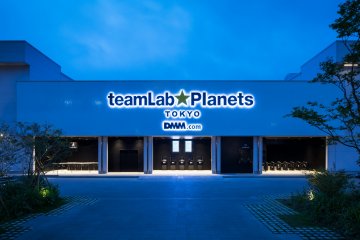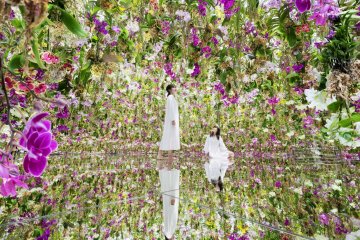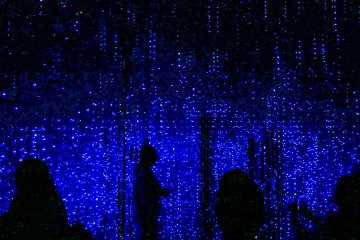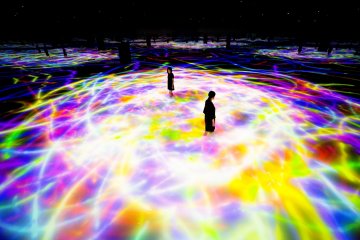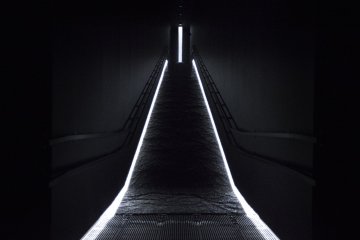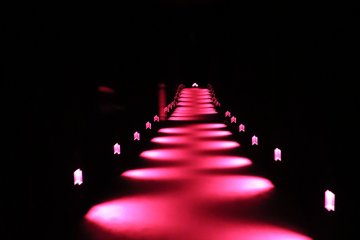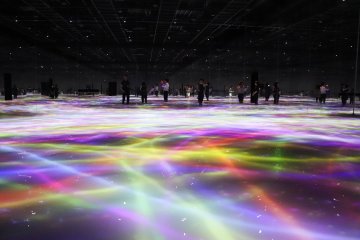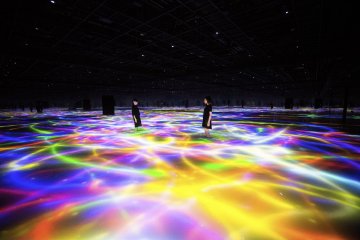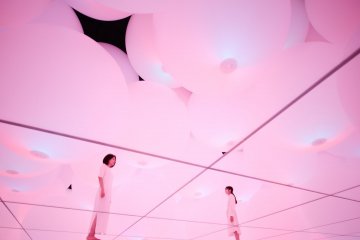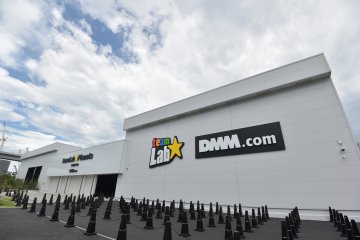Spanning across 10,000 square meters, TeamLab Planets Tokyo offers a massive space consisting of immersive light installations. This allows the body to completely be submerged into the digital art, blurring the lines between viewer and the work allowing visitors to think about their relationship not only with the digital artwork but also with the world.
Compared to teamLab Borderless in Odaiba, Planets in Tokyo has three main concepts that aim to echo our own selves: continuously moving, distinct colours and constant changes. Most, if not all of the installations try to show this – and helps set it apart from its sister installation.

What exhibits are there at TeamLab Planets?
The Infinite Crystal Universe

The Infinite Crystal Universe is an interactive installation of light sculpture just like pointilism, that uses dots of light and colour to create a picture. The work expresses the concept of the universe through changing light points that can infinitely spread in all directions.
Here, visitors can also use their smartphones to select what type of “star” they want to release in the installation. This shows how each element influence each other much like our everyday lives.
Floating in the Falling Universe of Flowers
Laid out in a dome-shaped area, Floating in the Falling Universe of Flowers recreates a seasonal year of flowers in bloom that changes with time.

Visitors can lie, sit down or stand up to immerse themselves in this artwork.
Drawing on the Water Surface
In Drawing on the Water Surface Created by the Dance of Koi and People - Infinity, the movement of the koi and flowers in the water is influenced by the presence of the people in the water. This highlights our relationship with nature and those around us and shows life continuously moving and changing.

Expanding Three-dimensional Existence in Transforming Space

Another featured work is Expanding Three-dimensional Existence in Transforming Space - Free floating, 12 colors. Here, the space is filled with giant spheres that float in different lights. People move along and when they strike the sphere, it changes colour and influences the surrounding orbs. Once again, this shows one our movement and actions can affect our surroundings.
This installation also shows the distinct colours as the colours of the spheres are not merely what we usually see. There are 9 other new colours including light in water, sunlight on water plants and plum – colours that we see everyday but cannot find words to describe.
Other exhibited works include Waterfall of Light Particles at the Top of an Incline, Soft Black Hole and Cold Life. They also mimic the three main concepts that teamLab Planets TOKYO aims to show.

How to enjoy TeamLab Planets
Comfort and mobility are your guidelines when dressing for teamLab Planets! The immersive experience likely requires you to move around quite a bit. For example, it is not uncommon for visitors to end up on all fours to get through the Soft Black Hole exhibit. And for the water-filled exhibit, the water level can rise up to knee-height for adults, so it is recommended to wear garments that can be rolled up to keep your clothes dry. You’ll be experiencing the exhibits barefoot, with your footwear stored away in provided lockers (free of charge). Of course, it is encouraged to take photos – and you'll get a special smartphone pouch to wear around your neck to keep your device dry and out of harm's way.
How to get tickets to TeamLab Planets
Generally, weekend passes are the most expensive. Weekday day passes (10am to 7pm) are cheaper and weekday night passes (7pm to 9pm) are the cheapest. Tickets are open for sale a month before and may get sold out quickly, so try to book them early to avoid disappointment.
What are the differences between TeamLab Planets and Borderless?
With the two TeamLab locations in Tokyo to choose from—TeamLab Borderless can be visited in nearby Odaiba—you may be wondering which one is worth visiting and how they differ? Borderless in Odaiba is larger with more exhibits and takes more time to explore, including a whole floor—The Athletic Forest—dedicated to younger audiences. On the other hand, if you are more pressed for time, Planets in Toyosu could be better as a more distilled, curated experience. While Borderless focuses on light and sound, Planets puts emphasis on surface and texture too, creating unusual sensory experiences like the Soft Black Hole – a room with a beanbag-like flooring that tests your attempt to transverse it while staying upright, or a water-filled exhibit where you can gaze at koi and colored light projections on the water's surface. For all their differences, they share some installations too, including a crystal light room, inflated ball room and floating light flower experience.
Note: teamLab is represented by Pace Gallery.



